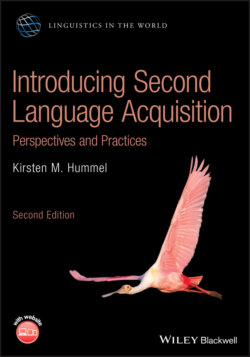Читать книгу Introducing Second Language Acquisition - Kirsten M. Hummel - Страница 29
2.5.1 L1 acquisition vs L2 acquisition contrasts
ОглавлениеThere are important differences characterizing the L1 and L2 acquisition situations. In this section, we will point out some dimensions along which learning a second language and learning a first language can be distinguished.
One very noticeable dimension of difference is that of age. Essentially all L1 learners are exposed to their first language in the earliest stages of life at a time when many other developmental processes are just beginning to appear. The infant has no other repertoire of signals to rely on, other than basic sounds, some gestures, and reflexive noises. The development of the brain and cognition are at an early stage; infants are incapable of advanced reflective thinking and planning. Thus language is an intrinsic component of the child's overall cognitive and social development. As the child develops, basic cognitive capacities increasingly emerge. Piaget, a Swiss psychologist, meticulously described and documented the various cognitive stages that young children go through, based on his clinical observations. For instance, he found that the one‐year‐old child has attained certain cognitive landmarks, such as object permanence, meaning that the child understands that objects which are no longer visible, as when a toy slips under the sofa, have not simply vanished from the universe, but can be found by peeking under the furniture. Similarly, the one‐year‐old is generally able to grasp the relationship between means and ends, as in comprehending that using a particular tool will allow him or her to attain an objective. Symbolic play, in which a child uses an object to imitate another object, emerges during the second year and indicates that the child is capable of increasing mental abstraction in representing objects. Thus the child's developing language accompanies her unfolding cognitive abilities; certain cognitive attainments coincide with language markers associated with those cognitive stages. For example, when a child acquires the means‐end concept, words marking success or failure, such as “there” and “uh‐oh” tend to appear in the child's vocabulary (Gopnik and Meltzoff 1993). Gopnik and Meltzoff (p. 243) claim that “[c]onceptual developments are not just prerequisites for semantic developments. Instead, linguistic variations may actually influence cognitive developments.” It is possible that children's early words and phrases influence and perhaps even shape their perception and cognitive development, that is, using “there” to emphasize her success in using a tool to reach an otherwise out‐of‐reach teddy bear might actually contribute to a child's understanding the concept that certain means or tools can be used to achieve results.
object permanence
The understanding that an infant gains during the latter part of the first year that objects continue to exist even though they may no longer be visible.
On the other hand, L2 learners, by definition learning the target language beyond infancy and early childhood, have already gone through a number of fundamental cognitive stages. Basic cognitive concepts such as the notion of object permanence and means‐end awareness have been attained. In addition, their cognitive development allows them metalinguistic awareness, meaning that they are able to reflect on language as a tool for thought or learning. Due to this awareness, L2 learners come to the language learning task equipped in a very different way from the L1 acquirer. As one example, some L2 learners may and often do prefer to learn through explicit exposure to the grammatical rules of the target language. Individuals with an analytical approach to learning may prefer to use logical reasoning skills to acquire parts of the L2. In L1 acquisition, young children do not yet have the same metalinguistic capacity. They are often incapable of recognizing that words are arbitrary labels for objects. Ask a toddler to suspend her intuitions and call her pet cat “dog” and you are likely to be greeted with puzzled incomprehension. Or try to get a two‐year‐old to focus on the form of his words in order to use the correct past tense form when he is not at the stage for doing so and his metalinguistic shortcomings will probably become rapidly evident. In the following dialogue Tommy ignores his mother's correction:
metalinguistic awareness
Ability to reflect on language as an object.
Tommy:
“Daddy goed.”
Mother:
“No, Tommy, Daddy went to work.”
Tommy:
“Daddy goed work.”
Once children are exposed to literacy skills in school, they develop metalinguistic skills and become increasingly able to reflect on and manipulate aspects of linguistic form.
